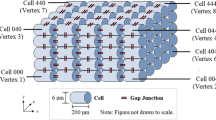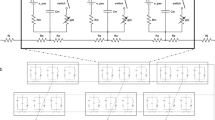Abstract
The potential generated in the smooth muscle of the vas deferens on release of a quantum of transmitter from a varicosity was analyzed using a three-dimensional bidomain continuum model. Current was injected at the origin of the bidomain; this current had the temporal characteristics of the junctional current. The membrane potential, intracellular potential, and extracellular potential, as well as the extracellular current, were then calculated throughout the bidomain at different times. Calculations were performed to show the effect of changing the anisotropy ratios of the intracellular and extracellular conductivities on the spread of current and potential in each of the three dimensions. These results provide a theoretical framework for ascertaining the time course of transmitter interaction at a varicosity following the secretion of a quantum of transmitter.
Similar content being viewed by others
References
Amedee, T., C. Mironneau and J. Mironneau. 1987. The calcium channel current of pregnant rat single myometrial cells in short-term primary culture.J. Physiol. 392, 253–272.
Bennett, M. R. 1972.Automatic Neuromuscular Transmission. Monographs of the Physiological Society. Cambridge, UK: Cambridge University Press.
Bennett, M. R. 1973. Structure and electrical properties of the autonomic neuromuscular junction.Phil. Trans. R. Soc. Lond B265, 25–34.
Bennett, M. R., L. Farnell, W. G. Gibson and N. A. Lavidis. 1997. Synaptic transmission at visualized sympathetic boutons: stochastic interaction between acetylcholine and its receptors.Biophys. J. (in press).
Bennett, M. R., L. Farnell, W. G. Gibson and S. Karunanithi. 1995. Quantal transmission at purinergic junctions: stochastic interaction between ATP and its receptors.Biophys. J. 68, 925–935.
Bennett, M. R. and W. G. Gibson. 1995. On the contribution of quantal secretion from close-contact and loose-contact varicosities to the synaptic potentials in the vas deferens.Phil. Trans. R. Soc. Lond. 347, 187–204.
Bennett, M. R., W. G. Gibson and R. R. Poznanski. 1993. Extracellular current flow and potential during quantal transmission from varicosities in a smooth muscle syncytium.Phil. Trans. R. Soc. Lond. B 342, 89–99.
Beyer, E. C., D. L. Paul and D. A. Goodenough. 1987. Connexin-43: a protein from rat heart homologous to a gap junction protein from liver.J. Cell Biol. 105, 2621–2629.
Beyer, E. C., J. Kistler, D. L. Paul and D. A. Goodenough. 1989. Antisera directed against connexin-43 peptides react with a 43-kD protein localized to gap junctions in myocardium and other tissues.J. Cell Biol. 108, 595–605.
Beyer, E. C., D. L. Paul and D. A. Goodenough. 1990. Connexin family of gap junction proteins.J. Membr. Biol. 116, 187–194.
Blennerhassett, M. G., M. S. Kannan and R. E. Garfield. 1987. Functional characterisation of cell-to-cell coupling in cultured rat aortic smooth muscle.Am. J. Physiol. 252, C555-C569.
Bolton, T. B., R. J. Lang, T. Takewaki and C. D. Benhan. 1985. Patch and whole-cell voltage clamp of single mammalian visceral and vascular smooth muscle cells.Experientia 41, 887–894.
Bozler, E. 1938a. Electric stimulation and conduction of excitation in smooth muscle.Am. J. Physiol. 122, 614–623.
Bozler, E. 1938b. The action potentials of visceral, smooth muscle.Am. J. Physiol. 124, 502–510.
Bozler, E. 1948. Conduction, automaticity and tonus of visceral muscles.Experientia 4, 213–218.
Brock, J. and T. Cunnane. 1987. Characteristics features of transmitter release from sympathetic nerve terminals.Blood Vessels 24, 253–260.
Bukauskas, F. F., R. P. Veteikis and A. M. Gutman. 1975. Model of a passive 3-dimensional anisotropic syncytium as a continuous medium.Biofizika 20, 1083–1086.
Bukauskas, F., A. Bytautas, A. Gutman and R. Veteikis. 1991. Simulation of passive electric properties in two- and three-dimensional anisotropic syncytial media. InIntracellular Communication F. Bukauskas (Ed.). Manchester, NY: Manchester University Press.
Bulbring, E. 1955. Correlation between membrane potentials spike discharge, and tension in smooth muscle.J. Physiol. 128, 200–221.
Bulbring, E., G. Burnstock and M. E. Holman. 1958. Excitation and conduction in the smooth mussel of the isolated taenia coli of the guinea pig.J. Physiol. 142, 420–437.
Burnstock, G. and M. E. Holman. 1962. Spontaneous potentials at sympathetic nerve endings in smooth muscle.J. Physiol. 160, 446–460.
Bywater, R. A. R. and G. S. Taylor. 1980. The passive membrane properties and excitatory junction potentials of the guinea-pig vas deferens.J. Physiol. 300, 303–316.
Carrier, G. F., M. Krook and C. E. Pearson. 1966.Functions of a Complex Variable: Theory and Technique. New York: McGraw-Hill.
Clerc, L. 1976. Directional differences in impulse speed in trabecular muscle from mammalian heart.J. Physiol. Lond. 255, 335–346.
Daniel, E., Y. Sakai, J. E. Fox and V. Posey-Daniel. 1984. Structural basis for function of circular muscle of canine corpus.Can. J. Physiol. Pharmacol. 62, 1304–1314.
Davies, L., Jr. and R. Lorente de Nó. 1947. Contribution to the mathematical theory of the electrotonus.Stud. Rockefeller Inst. Med. Res. 131, 442–496.
Eccles, J. C. and J. W. Magladery. 1937. The excitation and response of smooth muscle.J. Physiol. 90, 31–67.
Eisenberg, R. S., V. Barcilon and R. T. Mathias. 1979. Electrical properties of spherical syncytia.Biophys. J. 25, 151–180.
Engelmann, T. W. 1869. Zur Physiologie des Ureter.Pflugers Arch. 2, 243–293.
Gabella, G. and D. Blundell. 1981. Gap junctions of the muscles of the small and large intestine.Cell Tissue Res. 219, 469–488.
Geselowitz, D. B. and W. T. Miller. 1983. A bidomain model for anisotropic cardiac muscle.Ann. Biomed. Eng. 11, 191–206.
Henriquez, C. S. 1993. Simulating the electrical behaviour of cardiac tissue using the bidomain model.Crit. Rev. Biomed. Eng. 21, 1–77.
Henriquez, C. S. and R. Plonsey. 1990. Simulation of propagation along a cylindrical bundle of cardiac tissue-II: results of simulation.IEEE Trans. Biomed. Eng. 37, 861–875.
Hirst, G. D. S. and T. O. Neild. 1978. An analysis of excitatory junction potentials recorded from arterioles.J. Physiol. 280, 87–109.
Hoyt, R., M. Cohen and J. Saffitz. 1989. Distribution and three-dimensional structure of intercellular junctions in canine myocardium.Circ. Res. 64, 563–574.
Huizinga, J. and E. Chow, 1988. Electronic current spread in colonic smooth muscle.Am. J. Physiol. 254, G702-G710.
Jack, J. J. B., D. Noble and R. W. Tsien. 1975.Electric Current Flow in Excitable Cells. Oxford: Oxford University Press.
Larson, D., R. Gilbert and E. Beyer. 1992. Two dimensional coupling by gap junctions in cultured gastric smooth muscle monolayers.Am. J. Physiol. 263, G261-G268.
Lavidis, N. A. and M. R. Bennett. 1992. Probabilistic secretion of quanta from visualized sympathetic nerve varicosities in mouse vas deferens.J. Physiol. 454, 9–26.
Muler, A. L. and V. S. Markin. 1977a. Electrical properties of anisotropic neuromuscular syncytia. I. Distribution of electronic potential.Biofizika 22, 307–312.
Muler, A. L. and V. S. Markin. 1977b. Electrical properties of anisotropic neuromuscular syncytia. II. Distribution of a flat front of excitation.Biofizika 22, 518–522.
Muler, A. L. and V. S. Markin. 1977c. Electrical properties of anisotropic neuromuscular syncytia. III. Steady state of front of excitation.Biofizika 22, 671–675.
Myint-U, T. and L. Debnath. 1987.Partial Differential Equations for Scientists, and Engineers. New York: North Holland.
Nakazawa, K., N. Matsuki, K. Shigenobu and Y. Kasuya. 1987. Contractile response and electrophysiological properties in enzymatically dispersed smooty muscle cells of rat vas deferens.Pflugers Arch. Eur. J. Physiol. 408, 112–119.
Neunlist, M. and L. Tung. 1995. Spatial distribution of cardiac potentials around an extracellular electrode: dependence on fiber orientation.Biophys. J. 68, 2310–2322.
Peskoff, A. 1979. Electric potential in three-dimensional electrically syncytial tissues.Bull. Math. Biol. 41, 163–181.
Plonsey, R. 1989. The use of a bidomain model for the study of excitable media.Lectures Math. Life Sci. 21, 123–148.
Plonsey, R., C. S. Henriquez and N. Trayanova. 1988. Extracellular (volume conductor) effect on adjoining cardiac muscle electrophysiology.Med. Biol. Eng. Comput.,26, 126–129.
Pollard, A. E., N. Hooke and C. S. Henriquez. 1992. Cardiac propagation simulation.Crit. Rev. Biomed. Eng. 20, 171–210.
Prosser, C. L., C. E. Smith and C. E. Melton. 1955. Conduction of action potentials in the ureter of the rat.Am. J. Physiol. 181, 651–660.
Prosser, C. L. and N. Sperelakis. 1956. Transmission in ganglion free circular muscle from the cat intestine.Am. J. Physiol. 187, 536–545.
Purves, R. 1976. Current flow and potential in a three-dimensional syncytium.J. Theoret. Biol. 60, 147–162.
Roberts, D., L. Hersh, and A. Scher. 1979. Influence of cardiac fiber orientation on wavefront voltage, conduction velocity and resistivity in the dog.Circ. Res. 44, 701–712.
Roberts, K. V. and N. O. Weiss, 1965. Convective difference schemes.Math. Comp. 20, 272–299.
Rosenbleuth, A. and D. M. Rioch. 1993. Temporal and spatial summation in autonomic systems.Am. J. Physiol. 106, 365–380.
Rosenbleuth, A. 1936. Neuromuscular transmission in somatic and autonomic systems.Cold Spring Harb. Symp. Quant. Biol. 4, 132–142.
Roth, B. J. 1992. How the anisotropy of the intracellular and extracellular conductivities influences stimulation of cardiac muscle.J. Math. Biol. 30, 633–646.
Sepulveda, N. G. and J. P. Wilswo. 1987. Electric and magnetic fields from two-dimensional anisotropic bisyncytia.Biophys. J. 51, 557–568.
Sepulveda, N. G., B. J. Roth and J. P. Wikswo. 1989. Current injection into a two-dimensional anisotropic bidomain.Biophys. J. 55, 987–999.
Tiegs, O. W. 1925. The nerve net of plain muscle and its relation to automatic rhythmic movements.Aust. J. Exp. Biol. Med. Sci. 2, 157–166.
Tomita, T. 1990. Spread of excitation in smooth muscle.Prog. Clin. Biol. Res. 327, 361–373.
Toro, L. and E. Stefani, 1987. Ca2+ and K+ current in cultured vascular smooth muscle cells from rat aorta.Pflugers Arch. Eur. J. Physiol. 408, 417–419.
Tung, L. 1979. Three dimensional cable theory: a bidomain model.Biophys. J. 25, 214a.
Veenstra, R. and R. de Haan. 1988. Cardiac gap junction channel activity in embryonic chick ventricle cells.Am. J. Physiol. 254, H170-H180.
Author information
Authors and Affiliations
Rights and permissions
About this article
Cite this article
Henery, R., Gibson, W.G. & Bennett, M.R. Quantal currents and potential in the three-dimensional anisotropic bidomain model of smooth muscle. Bltn Mathcal Biology 59, 1047–1075 (1997). https://doi.org/10.1007/BF02460101
Received:
Accepted:
Issue Date:
DOI: https://doi.org/10.1007/BF02460101




